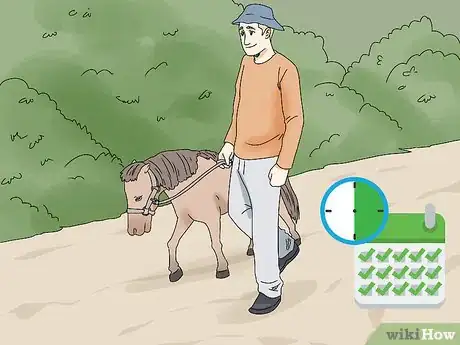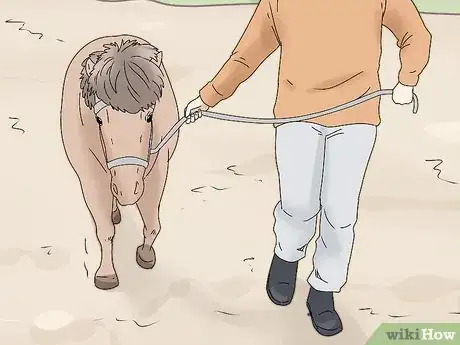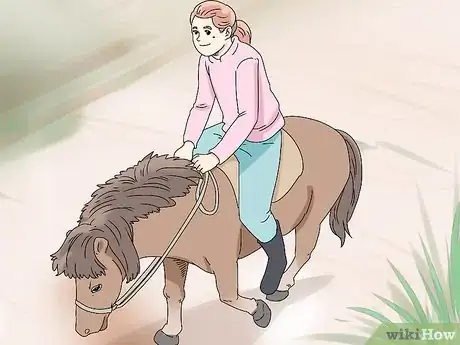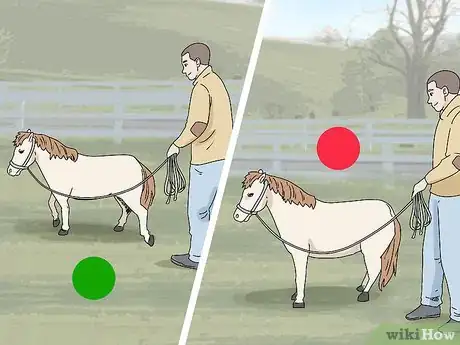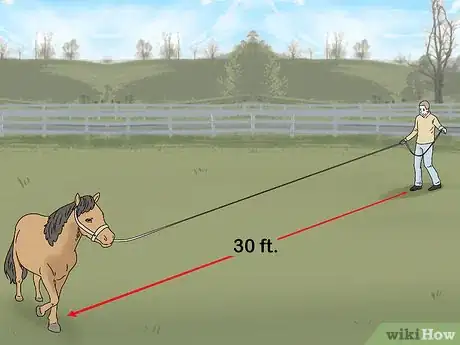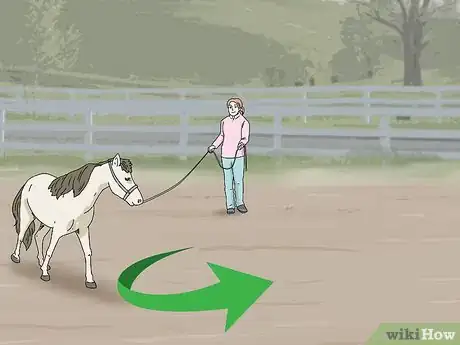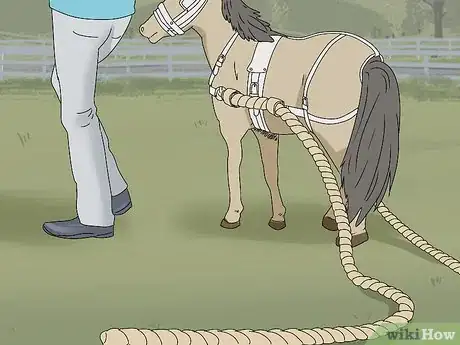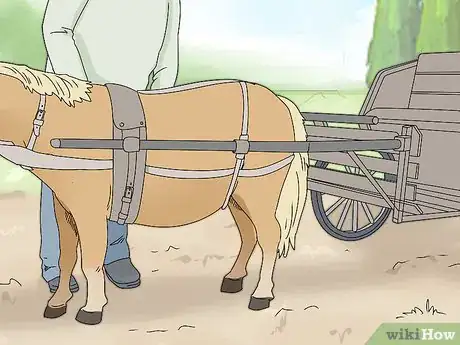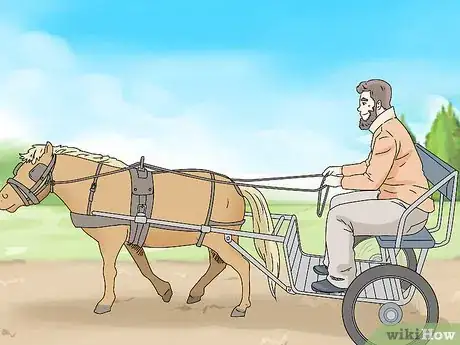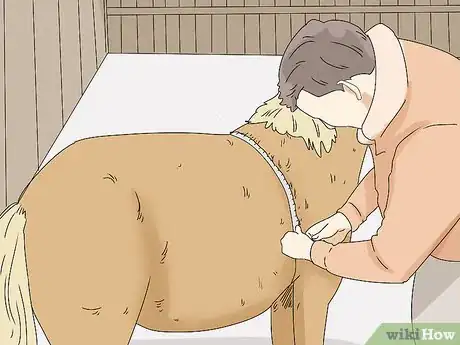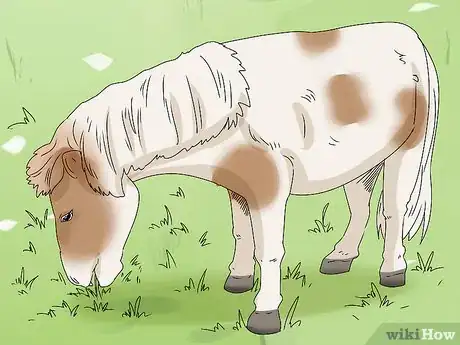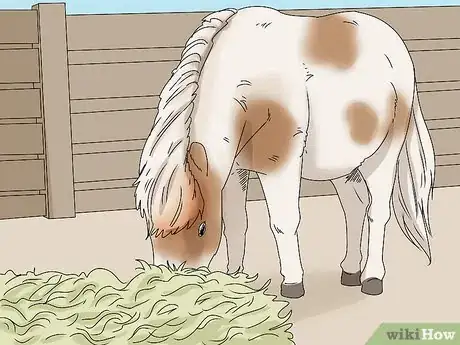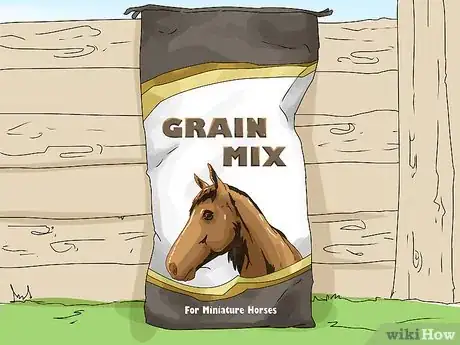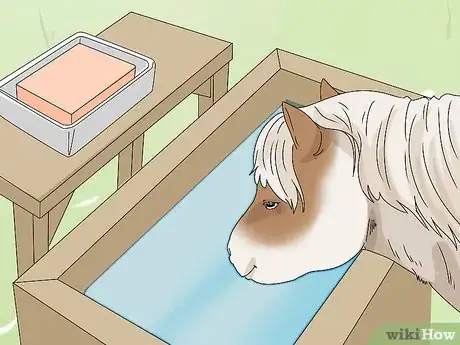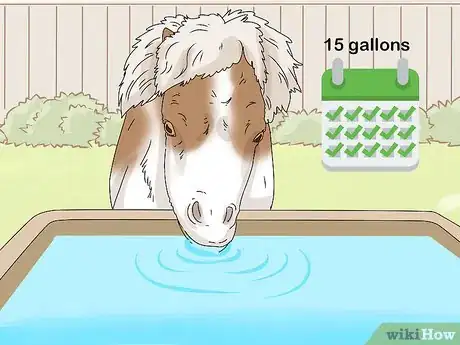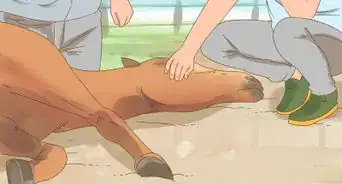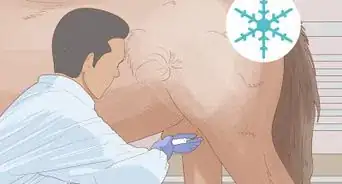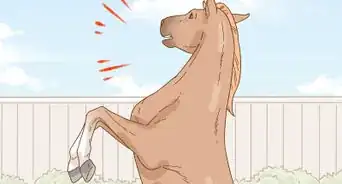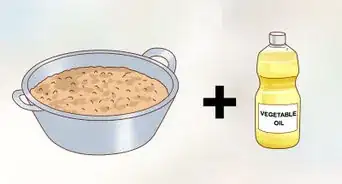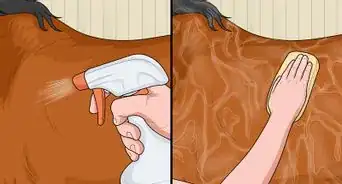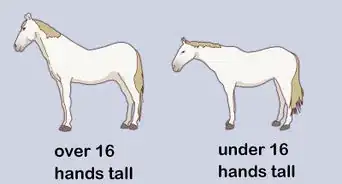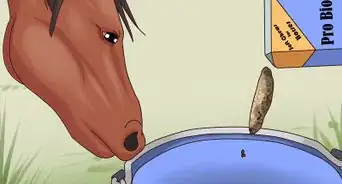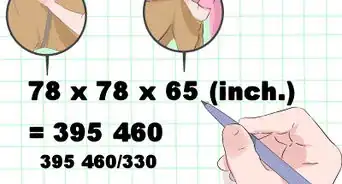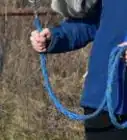This article was co-authored by Ryan Corrigan, LVT, VTS-EVN and by wikiHow staff writer, Danielle Blinka, MA, MPA. Ryan Corrigan is a Licensed Veterinary Technician in California. She received her Bachelor of Science in Veterinary Technology from Purdue University in 2010. She is also a Member of the Academy of Equine Veterinary Nursing Technicians since 2011.
There are 7 references cited in this article, which can be found at the bottom of the page.
This article has been viewed 51,178 times.
Miniature horses are a fun, adorable addition to your home or hobby farm. However, it’s easy for them to get out of shape. Since they’re so small, they can quickly become overweight. You can keep your miniature horse fit by exercising it, doing groundwork, and having it drive a small cart. Additionally, it’s important to feed it correctly so it doesn’t eat too much.
Steps
Exercising Your Miniature Horse
-
1Walk your horse for 30 minutes a day to begin conditioning. Bring your horse to your yard, a pen, or a pasture. Stand beside your horse and guide it with a line. Then, start walking and give your walk command. As you walk, direct the horse to trace the perimeter of the yard, pen or pasture.[1]
- Your walk command can be as simple as making a “smooching” sound. As an alternative, you might say, “Giddy up!”
- If you have a hill near your stable, walk the horse up and down it to increase the intensity of the workout.
- For example, you might start your horse’s workout by walking it 5 laps around the pasture.
-
2Trot your horse once walking laps becomes easy. Start jogging and give your horse 2 clicks with your tongue as a command to trot. When it’s first learning, encourage your miniature horse to pick up speed by patting its hindquarters. Use verbal praise to encourage your horse to keep trotting. Alternate between trotting and walking for the horse’s 30-minute workout.[2]
- If necessary, you can lightly tug on the horse’s line.
- Wait until your horse is able to complete its walking workout without exerting much effort before you add trotting.
Advertisement -
3Let children weighing less than 50 lb (23 kg) ride your mini horse. Saddle your miniature horse, then place the child on its back. Use your line to guide the horse around the pen or pasture. Stay at the horse’s side to keep it safe.
- Don’t leave the child and horse unsupervised.
- Miniature horses can’t carry more than 50 lb (23 kg) on their back, so only very small children should ride them.[3]
- Talk to your vet to verify the weight limits for your mini horse.
-
4Watch for signs of overwork as you exercise your horse. Working your horse too hard can make it become ill. Additionally, it will make the horse hate its routine, which may cause it to act aggressively toward you when it’s time to work. Here are some signs your horse is exerting too much energy:[4]
- Blowing a lot of air out of its nose
- Panting excessively
- Appearing tired
- Being listless after its workout
- Having a dry coat
- Acting stiff and sore the next day
Doing Groundwork
-
1Teach your horse to stop and go when you do. Stand at your horse’s side, holding its line in your hand. Then, begin walking forward and give your horse your walk command. Stop walking and make sure your horse follows suit. If it continues forward, step in front of it, hold up your hand, and say “Whoa.”[5]
- Your walk command can be something like making “smooching” sounds or saying, “Giddy up!”
- This exercise trains the horse to follow your motion, which will help it respond better if you want to attach it to a cart and drive it.
- If your horse doesn’t start walking with you, gently tug on its line to encourage it to walk.
-
2Longe (or lunge) your horse using a 30 to 40 ft (9.1 to 12.2 m) line. Fit a halter onto your horse, then attach the longe line to the lowest halter ring on the front of the horse. Make your horse move to the left by creating some slack in the line, then gently tugging it to the left. At the same time, hold up your right hand and wave it around to get your horse’s attention. After your horse moves to the left, switch hands and repeat for the right side.[6]
- If waving doesn’t get your horse to move, you can smack your body to make a sound, which will get the horse’s attention. As an alternative, you can snap a whip in the air. However, never strike your horse.
-
3Stop your horse by placing a long lunge whip in front of it and giving a command. Keep your horse's line in your hand so you have control. While your horse is walking, slowly start to reel it in toward you until it’s facing your direction. Then, hold up your hand with your palm facing the horse, and say, “Whoa.”[7]
- If your horse turns to the side and continues moving after you give the stop command, step in front of it again. Hold your hand out in front of the horse and say, “Whoa.” Continue to give the command until the horse stops walking.
-
4Walk your horse in a circle using the longe line. Stand at the side of your horse where it can see you. Then, turn your shoulders toward the direction you want the horse to walk. Wave your hand so your horse knows to follow your command. Finally, give your walk command.[8]
- Use your lunge whip to help guide your horse in the direction it should be going and how to walk on. It can help keep your horse at a safe distance from you as well. Don’t “crack” or “whip” it if you don’t need to, but just raise it in the air to encourage your horse to move or change directions.
- The horse should start walking in the direction you indicated. If it doesn't, step out in front of the horse to stop it. Then, try again.
- Hold onto your horse's longe line as it walks so you have extra control. You can lightly pull on the line if you need to get your horse's attention or encourage it to go in the direction you want it to walk.
-
5Change directions by showing the horse you want it to walk the other way. Step in front of your horse to get it to stop. Next, tilt your shoulder in the direction you want your horse to go. As you do this, wave your hand to get the horse's attention. Then, give your walk command.[9]
- If the horse goes in the wrong direction, stop it and try again.
Driving a Mini Horse
-
1Practice walking and stopping your horse from the ground first. Attach the horse’s reins to either side of its halter, and hold both reins in one hand. Move to the side of your horse, then give the walk command. To stop the horse, pull gently backward on the reins, as you would when riding a horse. Repeat this action until your horse responds easily to the commands.[10]
- It’s best to repeat this training for several days before you try attaching a cart.
-
2Teach your horse to turn with a tug on its reins. Attach the reins only on one side to make it easier for you to maneuver it during training. While standing beside your horse, gently tug on the rein to get the horse to follow the rein. It should turn its nose toward you. Once it does, release the pressure and unhook the reins. Switch sides and repeat the steps for that side. Keep working each side until the horse knows to turn its nose when you lightly apply pressure to the rein on that side.[11]
- This will help you get your horse to turn the cart by pulling on the reins.
-
3Walk your horse in just its harness to get it used to wearing it. Put the harness on your horse by buckling it. Then, put the bridle onto the horse and attach it to the harness. Next, connect the reins to the bridle. Check that the straps are secure but not too tight. Once the harness is on, give your horse the walk command. Use the reins to stop or turn the horse when necessary.[12]
- As you walk your horse, hold the straps that attach to a load or let them drag behind the horse.
- This helps your horse get used to wearing the harness.
- Get the best harness you can. If you can, avoid getting one made out of nylon. Instead, choose a leather harness.
- Once your horse is used to the halter, it’s ready to start pulling something.
-
4Attach heavy ropes to the harness to get your horse used to pulling. Tie or hook the ropes onto either side of the harness, and allow the rope to rest on the ground behind the horse. As the horse walks, it will be pulling the extra weight of the rope. Additionally, the rope will drag on the ground and mimic the drag of a cart.[13]
- The rope will help your horse practice pulling a cart. It helps the horse gradually get used to added weight and drag.
-
5Attach your mini horse to a small cart when it can pull with ease. Choose a cart that’s made for miniature horses or ponies. Hook the halter straps to either side of the cart. Then, the horse is ready to drive.[14]
- It’s best to check with your equine vet or horse trainer before attaching your horse to a cart. They can make sure your horse is fit enough to pull a cart.
-
6Ride in the cart or walk beside the horse as it hauls items. Use the reins to guide your horse as it pulls the cart. Watch the horse while it works to make sure it isn’t being overworked.
- If you’re riding in the cart, hold the reins behind the horse.
- If you’re using the horse to haul items, walk beside the horse and hold the reins to the side.
-
7Make sure your horse pulls no more than 3-5 times its weight. Estimate its weight using weight tape or weigh it on a livestock scale. Start your horse pulling lower weights and work it up if you want it to carry heavier loads.[15]
- You can always ask your vet for advice on how much weight your horse can pull.
- Don’t forget to add the weight of the cart into the weight of the load that the horse is pulling.
Feeding Your Mini Horse a Healthy Diet
-
1Graze your horse in a pasture for about half of its diet if you can. Your horse will enjoy foraging for food in the pasture, plus it will get a bit of a workout while it eats. Turn out your horse in the pasture or allow it to eat as you walk it.
- If your horse starts to get too fat, use a grazing muzzle to keep it from overeating while it’s out in the pasture.
- Minimize your horse’s access to the pasture in early spring. The fresh growth can cause laminitis in your horse and make them overweight due to the high sugar content.[16]
-
2Give your horse 1-2% of its weight in hay for 50% of its diet. Choose green grass or alfalfa-grass mixed hay. Opt for soft, fresh hay rather than dry hay. Put the hay in a bucket or feeding trough, not on the ground.
- Don’t put your miniature horse’s hay on the ground, as it will end up eating dirt or sand, which can cause colic.
- You can estimate your horse’s weight using weight tape. Ask your vet for help, if you’re struggling to estimate its weight. However, it’s best to weigh the horse on a livestock scale.
- The average weight for a mini horse is 200 pounds, which means the horse should eat around 2 to 4 pounds of roughage each day.[17]
-
3Supplement your horse’s diet with grain mix to maintain its weight and energy. Choose a grain mix that’s labeled for use with miniature horses or its weight range. Feed your miniature horse about 1 pound (0.45 kg) of grain a day, but divide it into two feedings.
- Always weigh the grain mix rather than measuring it out by volume.
- Check the label on your grain supplement to verify that you’re feeding your horse the correct amount. The recommended feeding amount can vary.
- If you give your horse too much grain mix, it will likely eat it, which can cause your horse to be overweight. Additionally, eating too much grain mix can make your horse gassy and uncomfortable.[18]
-
4Keep a salt block near your horse's water to encourage it to drink. Place it on a separate dish or attach it to the wall of the horse’s stable, if it has one. In addition to getting the horse to drink enough water, a salt supplement also replenishes your horse’s electrolytes.[19]
- You can find a salt block at a local feed store, livestock store or online.
-
5Give your horse at least 15 gallons (57 L) of fresh water daily. Give your horse water in clean buckets or a water trough. Replace the water at least twice a day to make sure it’s always fresh. When you give your horse water, check that the horse is drinking. It needs to drink at least 10 to 15 gallons (38 to 57 L) of water daily.[20]
- Horses will not drink stale water, so refill it even if the water bucket still has water in it.
- If you’re using buckets, provide at least 2 in your horse’s stable or pen.
- When you replace your horse’s water, always empty out the old water. Then, rinse out the water bucket or trough before you refill it.
Warnings
- Never stand directly behind your horse, even if it’s a miniature. It's normal for horses to kick behind them, so you may get hurt.[23]⧼thumbs_response⧽
- Don’t push your horse to do too much exercise too quickly. Overworking your horse can result in an injury, so give it time to get used to the increased exercise.⧼thumbs_response⧽
References
- ↑ https://www.theminiaturehorse.com/article/conditioning.htm
- ↑ https://www.theminiaturehorse.com/article/conditioning.htm
- ↑ https://www.hobbyfarms.com/mini-horses-for-mini-spaces-3/
- ↑ https://www.horseandrideruk.com/expert-advice/articles/fit-for-purpose-signs-of-overwork/
- ↑ https://www.youtube.com/watch?v=ttGbvRrsP_s&feature=youtu.be&t=29
- ↑ https://animals.mom.me/groundwork-training-mini-horses-6049.html
- ↑ https://animals.mom.me/groundwork-training-mini-horses-6049.html
- ↑ https://animals.mom.me/groundwork-training-mini-horses-6049.html
- ↑ https://animals.mom.me/groundwork-training-mini-horses-6049.html
- ↑ https://animals.mom.me/groundwork-training-mini-horses-6049.html
- ↑ https://animals.mom.me/groundwork-training-mini-horses-6049.html
- ↑ https://www.equisearch.com/articles/put-horse-horse-cart
- ↑ https://www.equisearch.com/articles/put-horse-horse-cart
- ↑ https://www.hobbyfarms.com/mini-horses-for-mini-spaces-3/
- ↑ https://www.hobbyfarms.com/mini-horses-for-mini-spaces-3/
- ↑ https://www.canr.msu.edu/uploads/resources/pdfs/feeding_the_miniature_horse_(e3068).pdf
- ↑ https://www.canr.msu.edu/uploads/resources/pdfs/feeding_the_miniature_horse_(e3068).pdf
- ↑ https://www.canr.msu.edu/uploads/resources/pdfs/feeding_the_miniature_horse_(e3068).pdf
- ↑ https://www.canr.msu.edu/uploads/resources/pdfs/feeding_the_miniature_horse_(e3068).pdf
- ↑ https://www.horseandrideruk.com/expert-advice/articles/fit-for-purpose-signs-of-overwork/
- ↑ https://animals.mom.me/groundwork-training-mini-horses-6049.html
- ↑ https://animals.mom.me/groundwork-training-mini-horses-6049.html
- ↑ https://animals.mom.me/groundwork-training-mini-horses-6049.html
